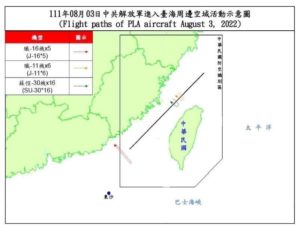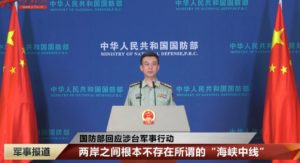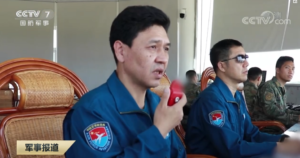
Learning from the First Phase of the Fourth Taiwan Strait Crisis
Learning from the First Phase of the Fourth Taiwan Strait Crisis
In April, I asserted that the lessons learned from Russia’s war in Ukraine might influence China’s People’s Liberation Army (PLA) to “accelerate the timetable for a smaller scale conflict” in the Taiwan Strait, short of a full-scale amphibious invasion (China Brief, April 8). On August 4, the PLA began a series of joint live-fire exercises in six exclusion zones surrounding Taiwan, including some that imposed on Taiwan’s territorial seas (81.cn, August 6). These exercises signal Beijing’s extreme pique that U.S. Speaker of the House of Representatives Nancy Pelosi led a Congressional delegation to meet with the leadership of Taiwan on August 2 and 3 (People’s Daily, August 3). Longtime students of PLA doctrine and military thought will recognize that these exercises have been in the works for the better part of two decades. In The Science of Joint Training, military deterrence is described as an essential objective of joint live-fire exercises:
The essence of military deterrence is to attack the will and sap the purpose, to win without fighting. It is manifest mainly in demonstrating military strength during peacetime, achieving the effect of “we must fight or we are an army of cowards”. Joint training particularly entails joint exercises involving real troops, real equipment, and live ammunition, and can directly demonstrate military strength, bringing into play the utility of military deterrence. [1]
The latest drills are ostensibly reminiscent of the live-fire exercises that the People’s Republic of China (PRC) conducted in 1995 and 1996 during the Third Taiwan Strait Crisis, but the surface resemblances belie deeper transformations within the PLA and their implications for the Chinese Communist Party’s (CCP) menu of options with regards to Taiwan. The Third Taiwan Strait Crisis was a contest of force posturing, first by the PRC to convince the Republic of China (ROC), or Taiwan, and the United States that Beijing was willing to employ the full scope of its military power to prevent moves by Taiwan toward greater international recognition. The United States struggled to calibrate an appropriate response to China’s actions, but eventually opted to send a second carrier battle group into the area. After the USS Nimitz group joined the USS Independence group, China curtailed further missile tests, in a move that appeared to be, “moderating [its] coercive posture.”[2] The aftermath found a belligerent, but chastened China, and led to a reprieve for the United States and Taiwan. Yet, in appearing to succumb to U.S. pressure, “Beijing’s civilian and military leaders had resolved that such a humiliation would never happen again.” [3] The currently unfolding series of diplomatic and military maneuvers may be seen as an epilogue to that episode from a quarter century earlier. China may now have sufficient confidence in its armed forces to resist countervailing posturing by the United States.
Table 1. Historical comparison of the Third Taiwan Strait Crisis and today
|
PLA Service Commands |
Third Taiwan Strait Crisis |
Current Day (as of Aug. 10) |
|
Second Artillery/PLARF |
6 DF-15 missile launches (July 1995)
4 DF-15 missiles launches (March 1996) |
9-11 DF-15 missile launches, at least one overflight of Taiwan (August 2022) |
| PLA Navy | Live-fire drills near Fujian (August 1995)
Joint amphibious exercises (November 1995) |
Surface and sub-surface joint exercises (August 2022)
Minelaying/sweeping exercises (August 2022) |
| PLA Air Force | Joint amphibious exercises (November 1995)
Joint amphibious exercises (March 1996) |
Combined air control exercises (August 2022)
UAV reconnaissance flights (August 2022) |
| PLA Ground Force | Joint amphibious exercises (November 1995)
Joint amphibious exercises (March 1996) |
MLRS live-fire exercises (August 2022) |
Rancor and Restraint
The latest round of live-fire exercises is consistent with the PLA’s doctrine on strategic deterrence. The 2020 edition of The Science of Military Strategy states that “through exercises, we can demonstrate our military’s combat capabilities to the opponent, but also cause the opponent to doubt our intentions, cause psychological panic, and produce a deterrent effect.” [4] Beyond the general objective of strategic deterrence, the PLA also has specific operational objectives intended to change the status quo. One of these operational objectives is to “thoroughly smash the so-called Strait median line,” according to National Defense University’s Strategic Studies Research Institute director, Meng Xiangqing (CCTV, August 6). The PRC Ministry of Defense telegraphed this intent on July 28, six days prior to Pelosi’s arrival in Taiwan. In a televised news conference, a Ministry of Defense spokesperson stated that there was “no such so-called Strait median line,” and that the PLA did not recognize such a boundary, despite decades of restraint and signaling around the median line as an operational line-of-contact between the PRC and Taiwan in the Taiwan Strait (CCTV, July 28).
 Taiwan MND notification reporting PLA warplanes crossing the median line on August 3 (source: ROC, MND)
Taiwan MND notification reporting PLA warplanes crossing the median line on August 3 (source: ROC, MND)Taiwan’s Ministry of National Defense (MND) has diligently reported on the PLA’s air and naval incursions, both before and during the latest crisis (see MND, ROC). Previous PLA incursions usually occurred in the southwestern corner of Taiwan’s Air Defense Identification Zone (ADIZ), with flights rounding Kenting to reach the eastern side of the island on rare occasions. In the latest series of incursions, aircraft have continued to cross into the southwestern quadrant of the ADIZ, but have also begun crossing the median line in the Taiwan Strait, which for decades served as a de facto boundary between the PRC and ROC militaries (Taipei Times, August 9). For example, on August 9, 45 PLA warplanes were detected in the airspace around Taiwan, with 16 of those aircraft crossing the median line in the Taiwan Strait; and on the previous day, 39 planes were detected, with 21 crossing the median line (MND, ROC, August 9; August 8). While this is an escalatory move that seeks to permanently challenge a decades-old norm, these flights have also turned back before approaching Taiwan’s coast and territorial airspace. The joint operational plan to restrict the sea and airspace surrounding Taiwan is consistent with what the PLA terms “restrictive military operations,” in which, “military exercises, weapon test firings, etc., delimit exercise areas, test areas or no-fly zones (no-sail zones), and implement control and isolation of local sea areas and airspaces.”[5] The strategic objective is to maintain escalation control, or “war control” (战争控制, zhangzheng kongzhi) in PLA parlance, while exerting strong deterrence pressure. Director Meng, of the PLA NDU, further explained that the 38 hours of prior notice for establishing the exercise exclusion zones was carefully calibrated to be less than the “international norm for these types of live-fire exercises of three days,” but more than the “emergency situation notice of no less than 24 hours” (CCTV, August 4). These details demonstrate both the sense of urgency behind the PLA’s actions, but also indicate residual self-restraint.
 A PRC Ministry of Defense press spokesperson declared the Taiwan Strait median line to no longer exist on July 28 (Source: CCTV)
A PRC Ministry of Defense press spokesperson declared the Taiwan Strait median line to no longer exist on July 28 (Source: CCTV)In the hours after the recent live-fire exercises were announced, rumors of amphibious tanks massing on the beaches and streets of Xiamen circulated on social media. These proved to be misinformation, but the threat of amphibious landings on the outlying islands persists. Unidentified drones conducted nighttime aerial reconnaissance over the fortress island of Jinmen on August 5, prompting the Taiwanese garrison to fire flares to ward them off and presumably interfere with their FLIR (forward-looking infrared) cameras (CNA, August 6). The Second Taiwan Strait Crisis in 1958 prominently featured the coastal islands held by Taiwan, and eventually concluded with a denouement that resulted in regular exchanges of artillery fire between PRC forces on the Mainland and ROC troops stationed on Kinmen and Mazu over the next two decades. In the PRC’s toolbox of options for conflicts below the threshold of full-scale amphibious invasion of Taiwan, seizure of outlying islands is one of the most achievable. As described by Ian Easton in his prescient book on the subject, “the outer islands form Taiwan’s first line of defense,” and could be used to “mount missile strikes, commando raids, and helicopter assaults on the mainland.” [6] Standing within sight of mainland beaches, these coastal islands generally lie within the territorial seas of the PRC. No extended air defense mission or logistic train would be required to attack them. The recently released Taiwan White Paper highlighted the fact that Kinmen’s water supply is provided by Fujian province (State Council Information Office, August 10). Seizing or neutralizing the coastal islands early would help reduce the complexity of a Taiwan amphibious invasion in the years to come. It is likely that an island seizure campaign was one option presented to the Chairman of the Central Military Commission (CMC) Xi Jinping, and his decision to opt instead for a partial air and naval blockade of Taiwan indicates a modicum of restraint on his part. That is to say, the latest air and maritime blockade operations are a grave situation for Taiwan, akin to “shutting the door to beat the dog,” but that Xi Jinping retains options that are far more severe (CCTV, August 4).
Evolution of Joint Command
 PLA Air Force and Army uniforms in a joint command post ( Source: CCTV)
PLA Air Force and Army uniforms in a joint command post ( Source: CCTV)In the Third Taiwan Strait Crisis, the PLA’s model for conducting joint operations had changed little from its legacy of stove-piped services last exhibited in the 1979 Sino-Vietnamese War. Training methods in the 1990s and early 2000s only included rudimentary opposing forces and inter-service rivalries were more prominent than inter-service coordination. The PLA refers to its legacy command model as “coordinated joint operations command and control” (协同性联合作战指挥控制, xietong xing lianhe zuozhan zhihui kongzhi), in which joint operations were de-conflicted by time or spatial phases at the campaign level. [7] In the years since, the PLA has greatly evolved its joint command model. Command coordination was extended down to the tactical level through the “unified group-style” of command and control (同一编组式指挥控制, tongyi bianzu shi zhihui kongzhi).[8] Combat units were then knit together through liaison officers from different services under the “distributed coordination-style” of command and control (分布协调式指挥控制, fenbu xietiao shi zhihui kongzhi), and those liaison officers were then empowered with limited command authority under “distributed embeds-style” of command and control (分布嵌入式指挥控制, fenbu qianru shi zhihui kongzhi). [9] Therefore, the joint command model and processes of the modern PLA represents a quantum leap beyond what was demonstrated in the last Taiwan Strait crisis. PRC state media indicated that the exercises are commanded by joint command posts and that the PLA Navy, Air Force, Rocket Force, and Joint Logistic Force were coordinated in joint fashion, although to what degree and in what missions, has largely yet to be detailed. Furthermore, Director Meng revealed that not only had units of different services operated in a joint manner, units from different theater commands were also operating jointly (CCTV, August 6). This would be evidence of the standardization of PLA joint methods of operations across theater commands and a potential demonstration of achieving “unit modularity”, an important milestone for the PLA (PLA Daily, June 9, 2014).
Still, the PLA could do more to demonstrate the quality of their joint reforms under its latest and potential future orchestrated live-fire campaigns. Observers have yet to detail close coordination between the PLA ground forces and other services. Strategic Support Force (SSF) officers ought to be embedded in each campaign and tactical echelon, in order to provide cyber and space-based support. Their contributions to the overall operation plan have yet to be detailed in open source reporting, even though establishing the SSF was one of Xi Jinping’s signature military reforms (China Brief, May 19, 2019). The contributions of the Joint Logistic Support Force, PLA Navy Marines, Naval Aviation, and Special Operations Forces have all yet to be described in detail, including the activities of China’s two operational aircraft carriers. In exercises as prominent as the most recent ones have been, every service and branch within each theater command would want to demonstrate their worth. Many commanders must be chafing that the Eastern Theater Command has featured so prominently at the exclusion of the other four Commands, thus far.
Conclusion
When I assessed that the PLA might initiate a controllable conflict scenario in the nearer term, it was predicated on uncertainty about China’s rapidly evolving military capabilities. The PLA had not exercised large-scale coordinated multi-theater joint operations since the amphibious assault operations in 1996. The current phase of what may prove to be the Fourth Taiwan Strait Crisis serves an important internal purpose in addition to signaling resolve to Taiwan and the United States. PLA academics and joint staff will be parsing the results of these live operations for years to come. The lessons learned in these exercises will help shape the next evolution of PLA methods of operations and joint command. The PLA academic community has long been keen to leapfrog the United States military’s model of net-centric warfare through the application of hypersonics, directed-energy weapons, artificial intelligence, and advanced cyber and space capabilities. The new Taiwan White Paper declares, “The wheel of history of China’s unification rolls ever forward, no one and no force can stop it” (State Council Information Office, August 10). This latest set of exercises may provide ample opportunity to better chart a course toward that outcome.
David D. Chen is an independent analyst located in Denver, CO. His areas of focus include PLA doctrine and training, space and cyber warfare, and emerging disruptive technologies.
The author would like to thank Dennis Blasko for his feedback on an earlier draft of this article.
Notes
[1] Original quotation cited in block quote is “军事威慑的本质是攻心夺志、不战而胜,其主要表现形式是在和平状态下展示军事实力,达到”不战而屈人之兵”之效。联合训练特别是实兵、实装、实弹的联合演习,可以直接显示军事实力,发挥军事威慑作用” from Xu Genchu (徐根初), ed., Science of Joint Training (联合训练学), Beijing, China: Military Science Publishing House, 2006, p. 80
[2] Patrick Tyler, A Great Wall, New York, NY: PublicAffairs, 1999, p. 35
[3] Ibid, p. 36.
[4] Xiao Tianliang (ed.), The Science of Military Strategy, National Defense University Press, 2020, p. 136, as translated in: In Their Own Words: Science of Military Strategy 2020, China Aerospace Studies Institute, 2022, https://www.airuniversity.af.edu/Portals/10/CASI/documents/Translations/2022-01-26%202020%20Science%20of%20Military%20Strategy.pdf.
[5] Ibid, p. 138
[6] Ian Easton, The Chinese Invasion Threat: Taiwan’s Defense and American Strategy in Asia, Arlington, VA: The Project 2049 Institute, 2017, p.114
[7] Wang Xixin (王西欣), “A Simple Analysis of the Nature and Characteristics of Integrated Command and Control (浅析一体化指挥控制的本质特征),” Junshi Xueshu (军事学术), 2004, No. 7, p. 30.
[8] He Songli (何松利), et al., “Crossing the Sea to Bind the Green Dragon—Panorama View of the Ground, Naval, Air Tri-Service ‘LIANHE-2008’ Real-Troop Exercise (跨海缚苍龙—陆海空三军“联合-2008”实兵演习全景扫描),” Qianwei Bao (前卫报), September 26, 2008, p. 2.
[9] Liu Xuenong (刘学农), et al., “Dissipating Gunsmoke Tells of Jointness—Record of Media Coverage of the Weifang Military Training Coordination Zone’s ‘LIANHE-2008’ Exercise (硝烟散后话联合—潍坊军事训练区‘联合-2008’演习采访闻思录),” Jiefangjun Bao (解放军报), November 11, 2008, p. 3; Fan Qingjun (范青军) and Liu Xuenong (刘学农), “Three Services Cross the Rubicon Together, Report of Victory Before the Gunsmoke Clears (三军联手渡天堑 硝烟未散捷报传),” Qianwei Bao (前卫报), 26 September 2008, p. 1.


